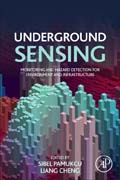
Underground Sensing: Monitoring and Hazard Detection for Environment and Infrastructure
Pamukcu, Sibel
Cheng, Liang
Almost all subsurface sensing applications can be classified into two categories: (i) event detection and, (ii) spatial process estimation. In event detection case, sensors are deployed strategically to detect an event, such as displacement or vibration. In spatial process estimation case, spatial distribution of a given physical phenomenon, such as chemical plume migration is estimated based on the samples taken by sensors that are typically placed in random locations. The majority of the currently available underground sensors provide time-ordered point measurements at strategically placed devices. Point monitoring works well if a plausible event location is known, in which case one may settle for recording vast amounts of benign data until the hazard event occurs. These sensors remain limited for global measurements of the subsurface in fully distributed manner. An alternative approach is to suppress all the benign data by allowing transmittal of signals only at the spatial and temporal vicinity of the event. This in essence is the fully distributed sensing capable of delivering the event signal where and when it might occur. New concepts and paradigms based on passively powered and/or on-demand activated, embeddable sensor platforms are needed to bridge the gap between real-time monitoring and global measurements. The first goal of this book is to bring to the target audience the technical and practical knowledge of existing technologies of subsurface sensing and monitoring based on a classification of their functionality. The second goal is to introduce emerging technologies and applications of sensing for environmental and geo-hazards in subsurface - focusing on sensing platforms that can enable fully distributed global measurements. The third goal is to explore the future of underground sensing that can meet demands for pre-emptive and sustainable response to underground hazards. This book is a one-stop-shop reference for underground sensing and monitoring needs of academics and professionals saving valuable research timeApplication cases for all technologies covered are described in detailFull 4 color images of equipment and application is provided enriching user experienceDesigned to cover a wide variety of underground sensors from Agriculture to Geo Hazards INDICE: 1. Overview of applied underground sensing and monitoring technologies 2. Acoustic, optical and electromagnetic sensing and monitoring 3. Geotechnical underground sensing and monitoring 4. Environmental underground sensing and monitoring 5. Wireless underground sensor networks 6. Fiber-optic underground sensor networks 7. Advances and challenges in underground sensing 8. Underground Sensing Strategies for the health assessment of buried pipelines 9. Outlook: advanced hybrid sensing for pre-emptive response
- ISBN: 978-0-12-803139-1
- Editorial: Academic Press
- Encuadernacion: Rústica
- Páginas: 616
- Fecha Publicación: 01/08/2017
- Nº Volúmenes: 1
- Idioma: Inglés
